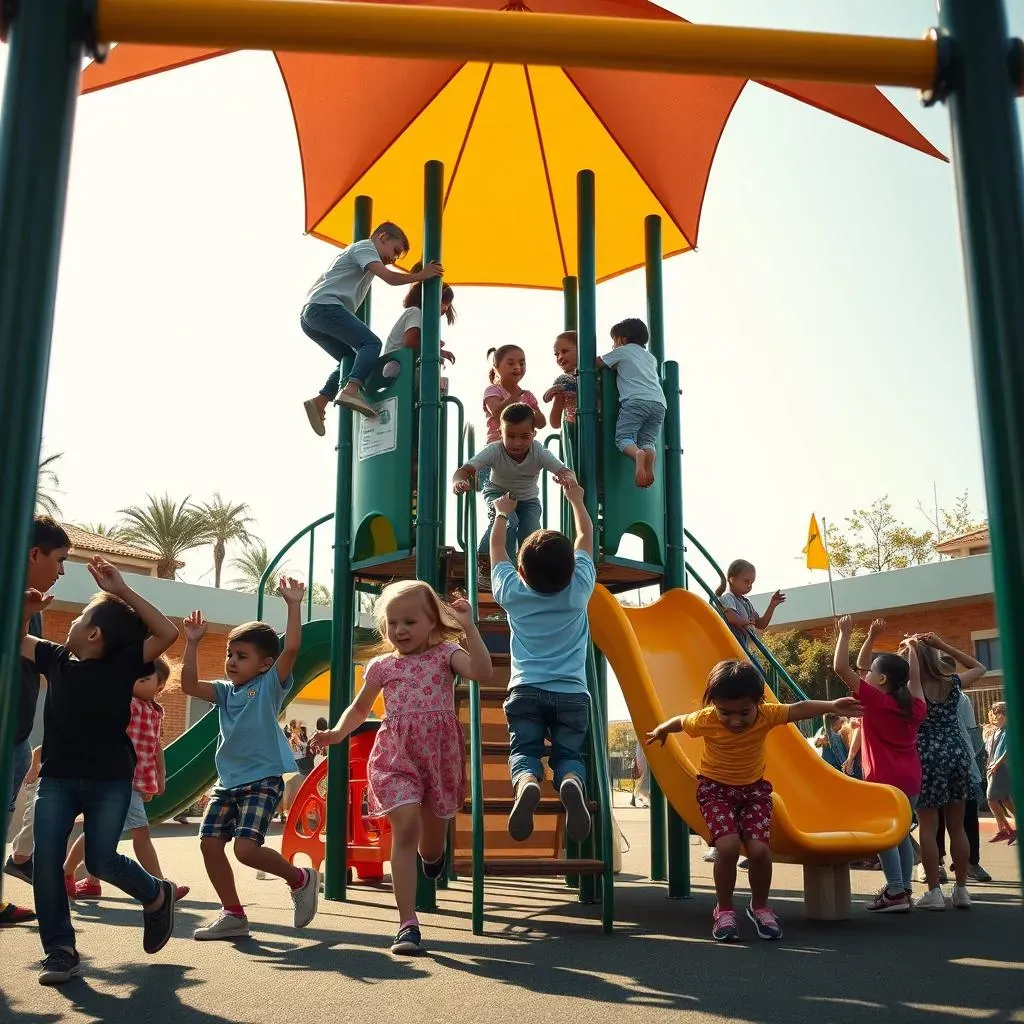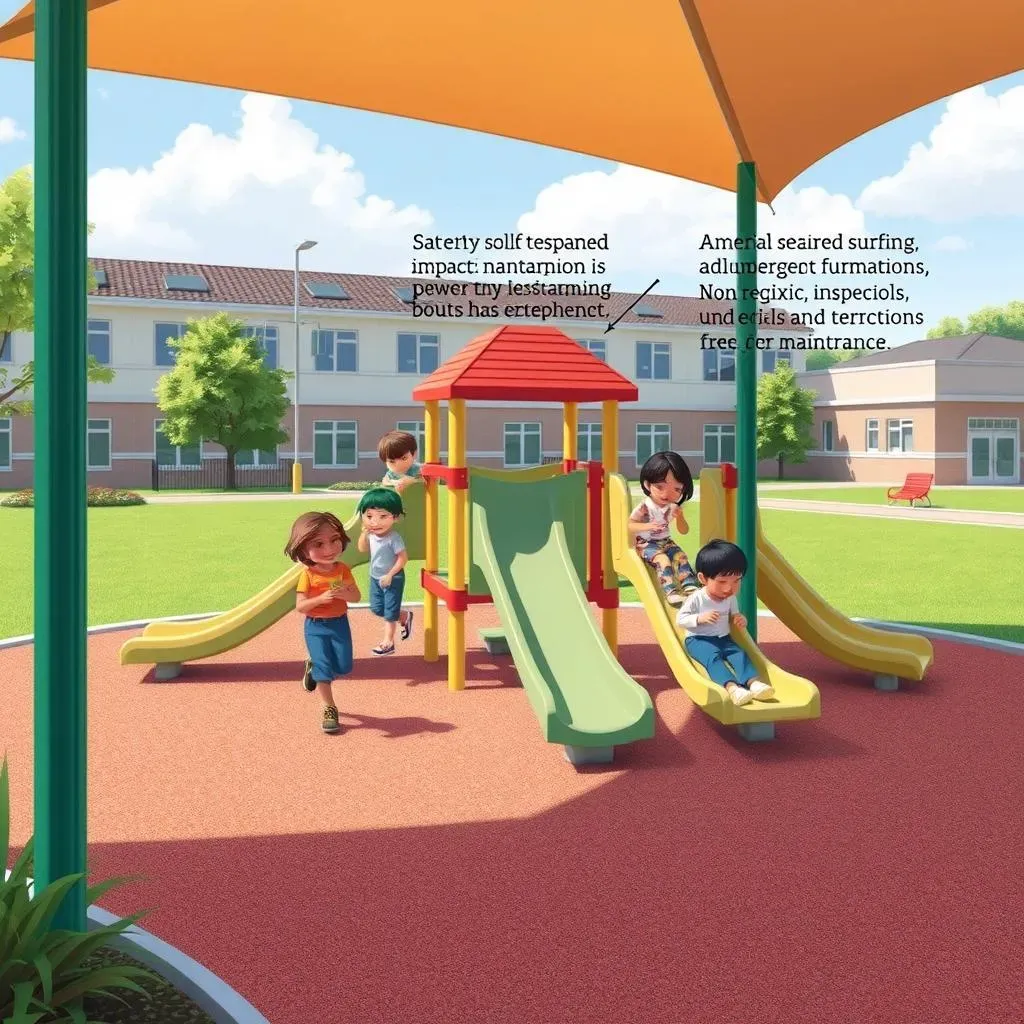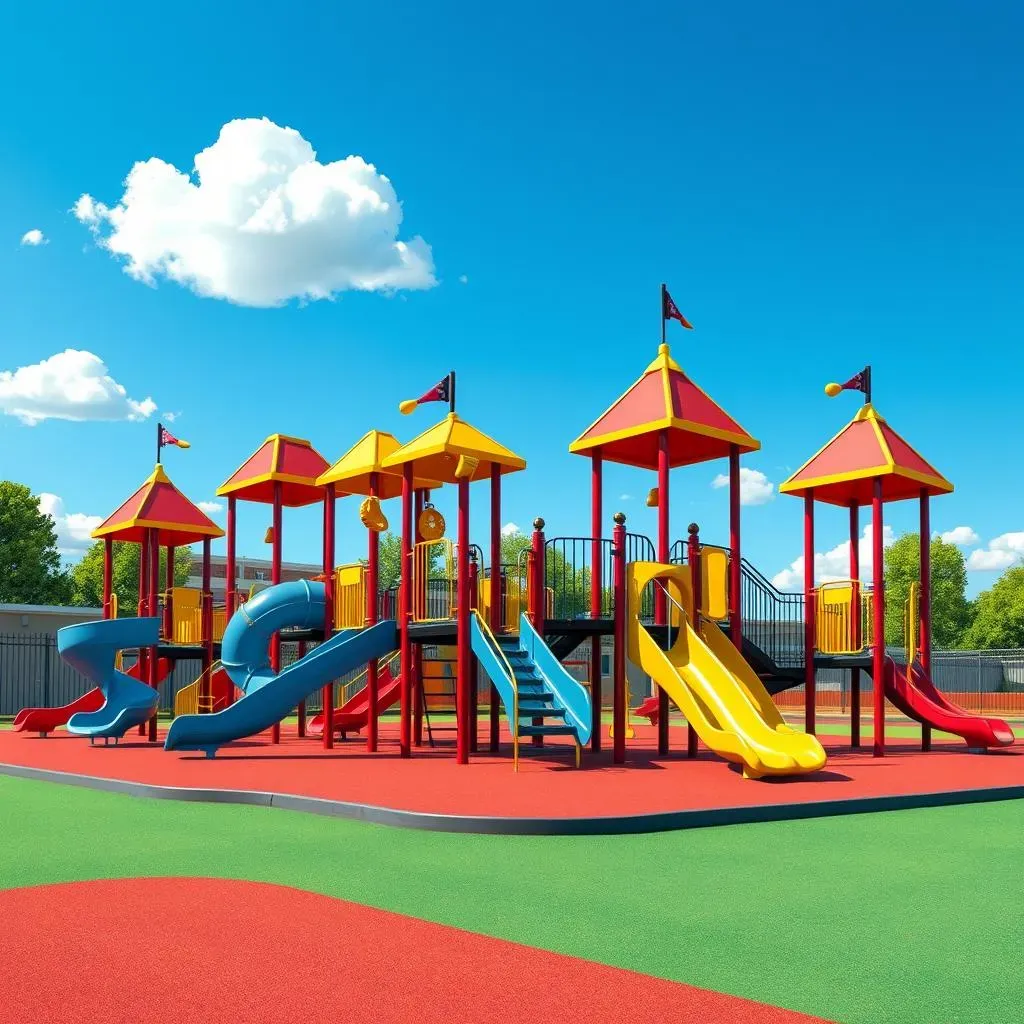Table of Contents
Ever wonder what makes a playground truly amazing? It's not just about the slides and swings; it’s about creating a space where kids can explore, learn, and grow. When it comes to commercial school playground equipment, there's a lot to consider. We're talking about more than just fun; we're talking about safety, inclusivity, and creating an environment that supports every child’s development. This article will guide you through the essentials of selecting the perfect playground equipment for your school. First, we'll discuss how to choose the right equipment that fits your needs and space. Then, we'll cover the crucial safety standards you need to know to ensure a secure play area. Next, we'll explore how to design a playground that’s both engaging and inclusive for all students. Finally, we’ll dive into budgeting and maintenance tips to keep your playground in top shape for years to come. So, get ready to transform your school’s outdoor space into an exciting adventure zone!
Choosing the Right Commercial School Playground Equipment

Choosing the Right Commercial School Playground Equipment
Understanding Your School's Needs
so you're thinking about new playground equipment? That's awesome! First things first, let's not get carried away by the coolest-looking slide just yet. We need to think about your school, like what’s the age range of the kids who'll be using it? Are we talking tiny tots or older kids? This matters because a toddler needs something different than a fifth-grader. Also, how much space do you have? A huge sprawling field is very different from a small patch of land. And, what’s your school all about? Are you focused on creative play, fitness, or something else? All of this will help narrow down the best choices for your space.
Think of it like choosing the right tool for a job. You wouldn't use a hammer to screw in a bolt, right? Same goes for playground equipment. You need to match the equipment to the kids who will be using it. For instance, a climbing wall might be great for older kids, but it could be a bit much for the little ones. You want to get it right so everyone can enjoy the playground and no one feels left out.
Types of Equipment and Their Benefits
Now, let's get to the fun part—the actual equipment! We've got slides, swings, climbing structures, and so much more. Slides are classics, offering a thrill and a way for kids to move. Swings are great for developing coordination and balance, plus, who doesn’t love soaring through the air? Climbing structures are fantastic for building strength and problem-solving skills. Then there are things like spinners and balance beams that challenge kids in different ways. And don't forget about inclusive play options, like ramps and sensory panels, which make sure every kid can join in the fun.
The key is to mix and match to create a diverse and engaging play area. It’s not just about having a lot of equipment, it's about having the right equipment. You want kids to be able to explore different types of play and develop a wide range of skills. A well-designed playground should offer something for everyone, regardless of their interests or abilities. Think of it as a mini-adventure park right in your schoolyard.
Equipment Type | Benefits | Age Suitability |
|---|---|---|
Slides | Fun, movement, spatial awareness | All ages |
Swings | Coordination, balance, sensory input | All ages |
Climbing Structures | Strength, problem-solving, gross motor skills | Older children |
Spinners | Balance, vestibular input, fun | All ages |
Ramps and Sensory Panels | Inclusion, accessibility, sensory exploration | All ages |
Considering Materials and Durability
Last but certainly not least, let's talk materials. You want something that can handle the rough and tumble of daily school use, right? Think about things like metal, plastic, and wood. Metal is super durable but can get really hot in the sun. Plastic is low maintenance and comes in all sorts of fun colors, but it might not be the most eco-friendly option. Wood is natural and beautiful, but it needs regular upkeep. You also need to think about the climate where you live. Will it be raining a lot? Is it super sunny? The weather can impact the lifespan of your equipment.
Durability is key. You don't want to be replacing equipment every year. You want something that’s going to last for a long time and stand up to all the kids playing on it. It’s also about choosing materials that are safe and non-toxic. Kids will be touching and climbing on this stuff, so it needs to be safe for them. By thinking about materials and durability, you can ensure your playground is not only fun but also a safe and long-lasting investment for your school.
Remember, choosing the right playground equipment is about more than just picking the first thing you see. It's about creating a space that supports the development of all your students, encouraging them to play, learn, and grow together. Take your time, do your homework, and you’ll be well on your way to building an amazing playground.
Understanding Safety Standards for School Playground Equipment

Understanding Safety Standards for School Playground Equipment
Why Safety Standards Matter
so we've talked about the fun stuff, now let's get serious. Safety is not just a suggestion, it's a must when it comes to commercial school playground equipment. Think about it: kids are naturally adventurous, and sometimes, that can lead to bumps and scrapes. But, we need to do everything we can to minimize risks and make sure they're playing in a safe place. This is where safety standards come in. These aren't just random rules; they're guidelines created by experts to help keep kids safe from serious injuries. They cover everything from the height of the equipment to the materials used, and even the spacing between different play structures. Ignoring these standards is like playing a game of chance with kids’ well-being. So, let’s take a look at what you need to know.
It's like building a house – you wouldn't skip the foundation, would you? Safety standards are the foundation of a good playground. They ensure that equipment is not only fun but also secure and reliable. These standards are in place to protect kids from falls, entrapment, and other common playground hazards. And remember, it's not just about avoiding accidents; it's also about creating an environment where kids can play freely without fear. A safe playground is a happy playground, and a happy playground is what every school wants.
Key Safety Guidelines to Keep in Mind
So, what are the key guidelines you need to be aware of? Well, there’s a bunch, but let's break it down. First, think about surfacing. The ground under and around the equipment should have some kind of soft material, like rubber mulch or engineered wood fiber, to cushion falls. Then, there's the height of the equipment – you need to make sure it's appropriate for the age group using it. Also, check the spacing between structures to avoid kids getting trapped. And, don't forget about the materials themselves – they need to be non-toxic, durable, and free from sharp edges. It’s a lot, but these guidelines are all designed to create a safer play environment.
Here’s a handy checklist to make things a bit easier:
- Surfacing: Soft, impact-absorbing materials under and around equipment.
- Height: Age-appropriate equipment heights to prevent serious falls.
- Spacing: Adequate space between structures to avoid entrapment.
- Materials: Non-toxic, durable, and free from sharp edges.
- Regular Inspections: Routine checks to identify and fix potential hazards.
Regular Inspections and Maintenance
so you've got your safe equipment installed. Great! But the job doesn't end there. Regular inspections and maintenance are super crucial. It’s like having a car; you need to check it regularly to make sure it’s running well. You should be doing frequent checks to look for any wear and tear, loose bolts, or damaged parts. And, if you find something, fix it right away. Don't wait for it to become a bigger problem. Also, make sure the surfacing is still in good condition. Over time, it might need to be topped up or replaced. Remember, keeping your playground safe is an ongoing job, not a one-time thing.
Think of it this way: a well-maintained playground is a safe playground. By keeping on top of inspections and maintenance, you're not just fixing things; you're also preventing accidents before they happen. It’s also about showing that you care about the kids who use the playground. It's a way of saying, "We want you to have fun, but we also want you to be safe." So, make sure you have a system in place for regular checks and maintenance. It’s time well spent and it's vital for the well-being of your students.
"The safest playground is the one that is regularly inspected and maintained." - A Wise Playground Expert
Designing Engaging and Inclusive School Playgrounds

Designing Engaging and Inclusive School Playgrounds
Creating a Variety of Play Experiences
so we've got the safety stuff covered, now let’s talk about making your playground a place where kids actually want to be. It’s not enough to just have equipment; you need to design a space that sparks their imagination and keeps them engaged. Think about creating different zones that offer a variety of play experiences. You could have an area for active play with climbing structures and swings, a quieter space for imaginative play with sand or water features, and maybe even a sensory garden for exploration. The idea is to offer a range of activities that cater to different interests and play styles. This way, every kid can find something they love and feel excited to use the playground.
It's like planning a party – you wouldn't just have one type of food or music, right? You'd want a variety to keep everyone happy. Same with a playground. You need a mix of activities that challenge kids physically, mentally, and creatively. A well-designed playground is one that offers something new and exciting every time kids step onto it. It should be a place where they can explore, discover, and let their imaginations run wild. So, let's think about how to make that happen.
Play Zone | Activities | Benefits |
|---|---|---|
Active Play | Climbing, swinging, running | Physical fitness, gross motor skills |
Imaginative Play | Sand, water, playhouses | Creativity, social skills, problem-solving |
Sensory Play | Gardens, textures, sounds | Sensory exploration, cognitive development |
Making Playgrounds Accessible for All
Now, let’s get to the real heart of the matter: inclusion. A truly great playground is one where every child, regardless of their abilities, can play and have fun. This means thinking about accessibility from the get-go. Things like ramps instead of just stairs, wider pathways for wheelchairs, and sensory-rich elements that cater to different needs are all important. It's not enough to just add a few "inclusive" pieces of equipment; you need to design the entire playground with accessibility in mind. This shows that you value every child and want them to have the same opportunities to play and grow.
Think of it like this: a playground should be a place where everyone feels welcome and included, not just a select few. It's about creating a space that breaks down barriers and allows all children to play together. It’s about fostering a sense of community and understanding. When you design a playground with inclusion in mind, you're not just building a play area; you're building a place where everyone belongs. And that's a pretty awesome thing to be a part of.
- Ramps: Provide access for wheelchairs and other mobility devices.
- Wide Pathways: Ensure easy navigation for all children.
- Sensory Elements: Incorporate textures, sounds, and visual cues for diverse needs.
- Transfer Platforms: Allow easy access to play structures for children with mobility challenges.
- Inclusive Swings: Provide support for children with varying abilities.
Incorporating Natural Elements
Last but not least, let's talk about bringing nature into your playground. It’s not just about metal and plastic; natural elements like trees, plants, and rocks can add a whole new dimension to the play experience. Think about creating a small garden where kids can dig and plant, or a rock area where they can climb and explore. Natural elements can not only make the playground look more appealing but also offer a range of sensory and learning opportunities. They can help kids connect with nature, develop a sense of wonder, and learn about the world around them. So, let's make sure we're not just building playgrounds, but also creating spaces that are connected to nature.
It’s like giving kids a little piece of the outdoors right in their schoolyard. Natural elements can stimulate their senses, spark their curiosity, and offer opportunities for unstructured play. It’s about creating a space that feels alive and vibrant, not just a collection of equipment. A playground that incorporates nature is a playground that feels more welcoming, more engaging, and more beneficial for kids. So, let’s think about how we can bring a bit of the great outdoors into our playgrounds.
"The best classrooms are roofless." - A wise educator.
Budgeting and Maintaining Your Commercial School Playground Equipment

Budgeting and Maintaining Your Commercial School Playground Equipment
Creating a Realistic Budget
Alright, so you’re dreaming of this awesome playground, but let’s talk real numbers. Setting a budget for commercial school playground equipment can feel like a rollercoaster, but it doesn't have to be scary. First thing, figure out how much money you actually have to spend. This includes not just the equipment itself, but also things like installation costs, surfacing, and maybe even some landscaping. Don’t forget to factor in potential costs for ongoing maintenance. It's like planning a road trip, you've got to know how much gas you'll need, and maybe a little extra for unexpected stops. So, be honest about what you can afford and try to create a budget that's realistic for your school.
Now, let’s get into the nitty-gritty. It's tempting to go for all the bells and whistles, but sometimes, less is more. Prioritize what's most important for your students and your space. Maybe you don't need the biggest climbing structure, but a few well-chosen pieces that offer a variety of play opportunities. Also, consider phasing your purchases. You could start with the essentials and add more pieces over time as your budget allows. Remember, it's about creating a play space that’s both fun and functional, not just about having the most expensive equipment. So, take a deep breath, plan carefully, and you'll be well on your way to creating a playground that fits your budget.
Budget Item | Considerations | Tips |
|---|---|---|
Equipment Costs | Type, size, materials | Prioritize essential pieces, consider phasing |
Installation Costs | Labor, site preparation | Get multiple quotes, look for discounts |
Surfacing Costs | Material type, area coverage | Choose durable, cost-effective options |
Maintenance Costs | Regular inspections, repairs | Set aside a maintenance fund |
Extending the Life of Your Equipment
so you’ve got your playground installed and the kids are loving it. Great! But the story doesn’t end there. Just like a car needs regular check-ups, your playground equipment needs ongoing care to keep it safe and fun for years to come. This is where maintenance comes in. Regular inspections are key – walk around the playground frequently to look for any loose bolts, cracks, or wear and tear. If you see something, fix it right away. Don’t wait for a small problem to become a big one. Also, keep the playground clean – remove any trash or debris. This not only keeps the playground looking good but also reduces the risk of accidents.
Beyond the basics, think about protecting your equipment from the elements. If you live in an area with harsh weather, consider using protective sealants or covers to prevent damage from sun, rain, or snow. And don’t forget about the surfacing – make sure it’s still in good condition and provides adequate cushioning. Regular maintenance might seem like a chore, but it’s an investment in the long-term safety and enjoyment of your playground. Think of it as a way of showing you care about the kids and the space they play in. So, let’s make sure we’re taking good care of our playgrounds so they can bring joy to kids for many years to come.
"A well-maintained playground is a testament to a school's commitment to safety and fun." - A thoughtful playground designer
Wrapping Up Your Playground Project
Choosing the right commercial school playground equipment is a big task, but it's also an incredibly rewarding one. By carefully considering safety, inclusivity, and your budget, you can create an outdoor space that will benefit your students for years. Remember, the best playgrounds are those that encourage active play, spark imagination, and provide a safe space for all kids to thrive. So, take the time to plan, choose wisely, and watch as your school's playground becomes the heart of fun and learning.